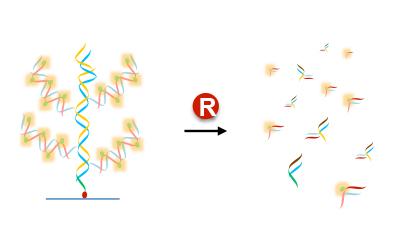

A nanotree made of DNA can be reversed under standard physiological conditions without burning or other harsh interventions, according to a new study led by Yong Wang, associate professor of biomedical engineering at Penn State.
Credit: Penn State
DNA-based straight and branched polymers or nanomaterials that can be created and dissolved using biocompatible methods are now possible thanks to the work of Penn State biomedical engineers.
Synthetic polymers may lead to advances in a broad range of biological and biomedical applications such as drug delivery, molecular detection and bioimaging.
“Achieving reversibility of synthetic polymers and nanomaterials has been a long-standing dream for many biomedical engineers,” said Yong Wang, associate professor of biomedical engineering. “Scientists want to see these polymers reverse or disappear when we are finished with them, but that often involves the use of high temperatures and chemical solvents. With that idea in mind, the aim of our study was to create synthetic polymers that would decompose without the use of harsh elements or increased stress. In principle, the polymers could be further tuned to synthesize a diverse array of nanomaterials or bulk materials.”
To assemble the dynamic polymers, researchers linked DNA initiators — straight DNA strands with a single binding domain — to two DNA monomers with multiple domains. The bonded molecules formed a linear double-stranded DNA structure with a separate and functional side group. The researchers then created a trigger molecule that attached to the side group and initiated a “reverse without the involvement of any non-physiological factors,” according to a recent article in Angewandte Chemie International Edition.
The researchers also showed that branched polymers responded to the same technique.
Branched polymers synthesized with a straight polymer and two DNA monomers yielded two functional side groups with the ability to reverse when induced by two molecular triggers.
The researchers performed preliminary testing of the model in water, with subsequent testing conducted on synthetic antibodies. Antibody trials proved that growth and depolymerization of straight and branched polymers were also possible on the microparticle surface and in the extracellular matrix.
Wang and his team are hopeful that by uniting the polymers with various molecules and materials, their findings will hold value for a number of wide-ranging applications.
###
Collaborating with Wang on the project were Niancao Chen, research fellow at Boston Children's Hospital, Harvard Medical School and recent Penn State Ph.D and Xuechen Shi, Penn State graduate student in bioengineering.
Integrated National Science Foundation Support Promoting Interdisciplinary Research and Education and the National Institutes of Health Heart, Lung, and Blood Institute supported this work.












